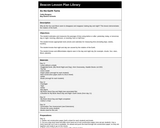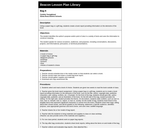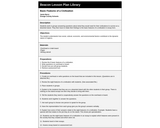
In this lesson, students examine literary techniques authors use to grab readers' attention.
- Subject:
- English Language Arts
- Material Type:
- Lesson Plan
- Provider:
- Beacon Learning Center
- Author:
- Beacon Learning Center
- Date Added:
- 04/23/2019

In this lesson, students examine literary techniques authors use to grab readers' attention.

In this lesson, students will discover baby animals look similar to their parents and match pictures of adult animals with their offspring.

In this lesson, students will demonstrate their understanding of the elements of a short story by collectively creating stories within a group.

In this lesson, students read Shakespeare's "Julius Caesar", then research the assassination of another historical figure.

In this lesson, students create clocks, explore the concept of rotation, and participate in a classroom demonstration of the Earth and the Sun during the night and day. Students will also create a book about day and night. A reproducible copy of the book and a teacher checklist are included.

In this lesson, students will be able to process a variety of information on the dropping of the atomic bombs on Hiroshima and Nagasaki. The lesson emphsis is on discerning factual from interpretive information.

In this lesson, students will make sure that the purpose of an oral presentation or speech and the intended audience are compatible in order to become better speakers.

In this lesson, students will select and record a poem, article, or short story that incorporates images and sounds within the text to elicit emotions in the listener. They will write an explanation of how sounds and images are used to elicit the emotional response.

Using a paper bag or a gift bag, students create a book report providing information on the elements of the book.

In this lesson, students will apply their knowledge of operations with decimals by participating in a classroom shopping adventure.

In this lesson, students learn the relationships among fractions, decimals, and percents. Students also express a given quantity in a variety of ways, such as fractions, decimals, or numbers expressed as percents. Students convert a number expressed in one form to its equivalent in another form.

In this lesson, students work in groups answering questions about what they would need for their civilizations to survive on a deserted island. They then have to relate their findings to the basic features of a civilization in essay form.

In this lesson, students write their own autobiographies and share them with the class.

In this lesson, students will learn to distinguish between emotional and logical arguments in advertising.

In this lesson, students work in cooperative groups to prepare presentations on business organization and Big Business during the second part of the Industrial Revolution (1860-1910) in the United States.

Students select a person to research for biographical information. Utilizing resources in the Media Center, students record information on note cards; students then interpret and categorize information for appropriate placement on a graphic organizer.

In this lesson, students write a biographical poem about themselves using an easy formula.

Using resource materials, students will write a biographical research paper.

In this lesson, students engage in a process of reading using Bloom's Taxonomy in order to provide them with a tool to better understand whatever they are reading.

In this lesson, students create an oral presentation that uses a visual aid to sell their books to their classmates with the goal of trying to get their classmates interested in reading the book.